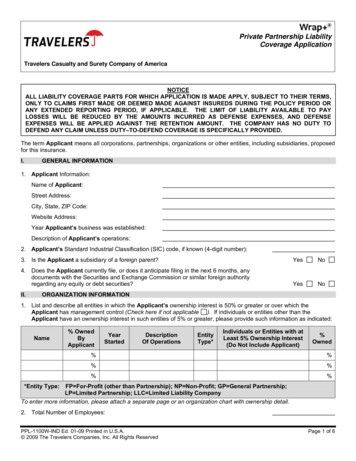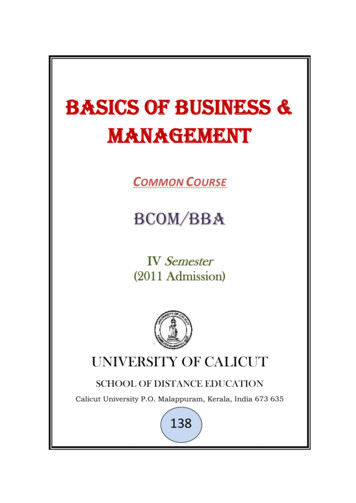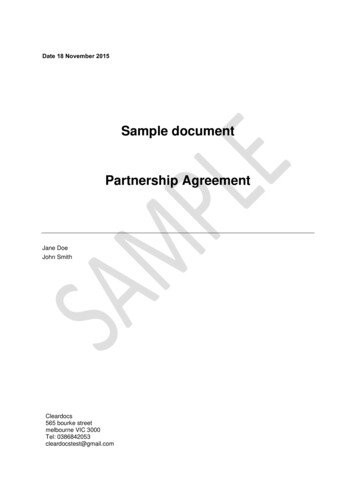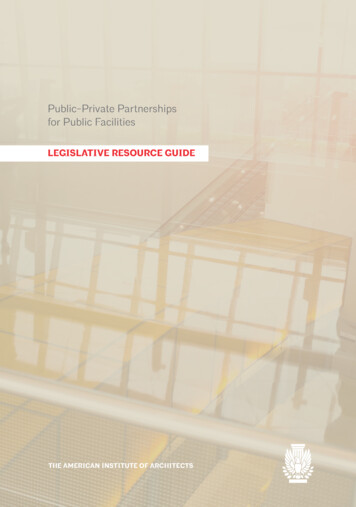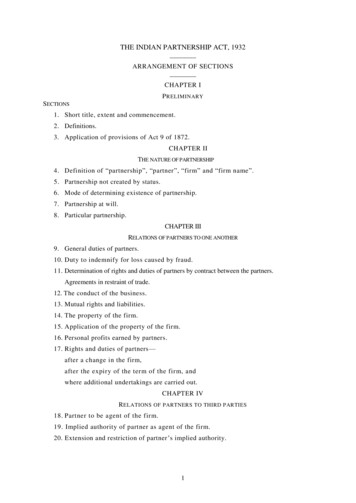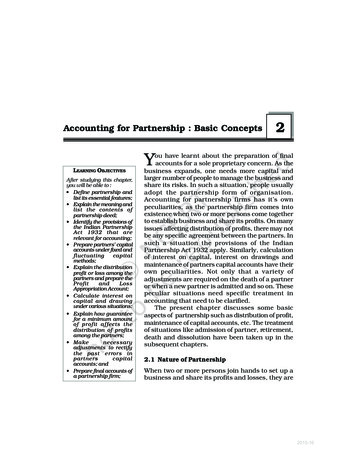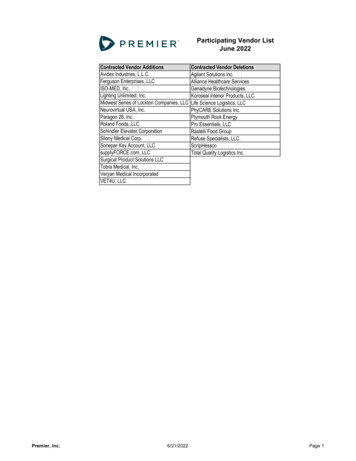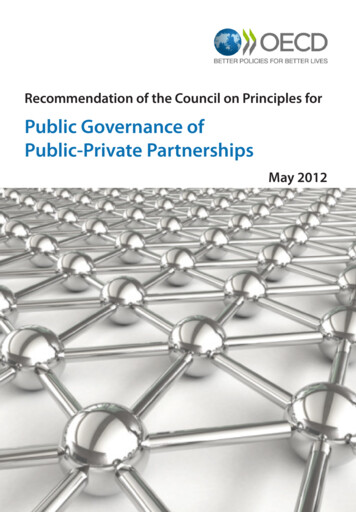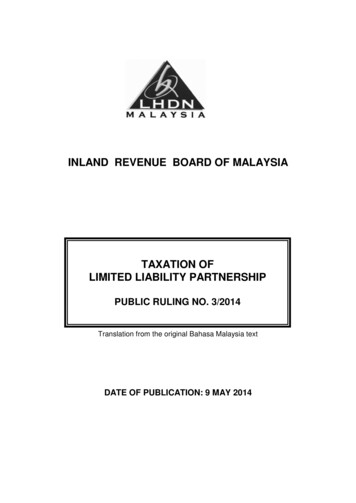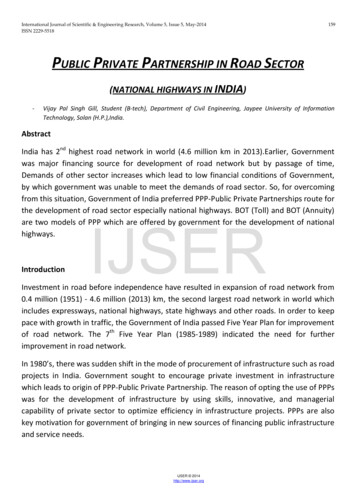
Transcription
International Journal of Scientific & Engineering Research, Volume 5, Issue 5, May-2014ISSN 2229-5518159PUBLIC PRIVATE PARTNERSHIP IN ROAD SECTOR(NATIONAL HIGHWAYS IN INDIA)-Vijay Pal Singh Gill, Student (B-tech), Department of Civil Engineering, Jaypee University of InformationTechnology, Solan (H.P.),India.AbstractIndia has 2nd highest road network in world (4.6 million km in 2013).Earlier, Governmentwas major financing source for development of road network but by passage of time,Demands of other sector increases which lead to low financial conditions of Government,by which government was unable to meet the demands of road sector. So, for overcomingfrom this situation, Government of India preferred PPP-Public Private Partnerships route forthe development of road sector especially national highways. BOT (Toll) and BOT (Annuity)are two models of PPP which are offered by government for the development of nationalhighways.IntroductionIJSERInvestment in road before independence have resulted in expansion of road network from0.4 million (1951) - 4.6 million (2013) km, the second largest road network in world whichincludes expressways, national highways, state highways and other roads. In order to keeppace with growth in traffic, the Government of India passed Five Year Plan for improvementof road network. The 7th Five Year Plan (1985-1989) indicated the need for furtherimprovement in road network.In 1980’s, there was sudden shift in the mode of procurement of infrastructure such as roadprojects in India. Government sought to encourage private investment in infrastructurewhich leads to origin of PPP-Public Private Partnership. The reason of opting the use of PPPswas for the development of infrastructure by using skills, innovative, and managerialcapability of private sector to optimize efficiency in infrastructure projects. PPPs are alsokey motivation for government of bringing in new sources of financing public infrastructureand service needs.IJSER 2014http://www.ijser.org
International Journal of Scientific & Engineering Research, Volume 5, Issue 5, May-2014ISSN 2229-5518160PPP’s ConceptAcross all infrastructure sectors, Government face problem for filling gap between budgetand needs of public both in advance and developed countries. The result of it was PPPPublic Private Partnerships.‘PPP’ is partnership between public sector entity and private sector entity for thedevelopment and management of infrastructure for public purpose for a specified periodpartner has been procured through a transparent and open procurement system.PPP does not mean the private ownership of infrastructure, but the government remainsowner of infrastructure and full fill the needs of public. With PPP approach, Government setthe stages like first of all, find best private partner who will finance, design, built, operateand maintain the project. Private partner recovers his initial investment through service feepaid by government or user directly. Finally, PPP allocates specific risk to partner that inbetter position to manage as government (public entity) controls legal frameworks,changing in jurisdiction and regulation, where as Private sector put its best in designing,investment and operation. Some risks are shared by both like sufficient use of demand forproject. Fig 1 shows the Risk Transfer from Public to Private from Design-Bid-Build toDivestiture.IJSERFig 1 Risk Transfer from Public sector to Private Sector.PPP in National HighwaysIJSER 2014http://www.ijser.org
International Journal of Scientific & Engineering Research, Volume 5, Issue 5, May-2014ISSN 2229-5518161National Highways played a key role in economic development of country by connectingstates, capitals, ports and adjacent countries. National highway constitutes only 2% of roadnetwork in India but carries about 45% of total road traffic (2013).Government of India was unable to meet the required demands regarding development ofNational Highways due to demands of other sectors. So, for development and maintenanceof National Highways involve private sector through the PPP route to meet publicrequirements and overcome the inefficiencies in road network. Involvement of PrivateSector in development of National Highway Network is through PPP models such as BOTBuilt Operate Transfer and Design and Construction Contract.In Design and Construction Contract, only single entity design and construct theinfrastructure, projects known as Design-Build Projects. This model of PPP is not preferableas whole project (Design Construction) responsibility is on single entity. For Roadconstruction, Government of India prefers BOT as it is less risky and proper allocation ofresources and skills of private sector. BOT (Toll) and BOT (Annuity) are two variants of BOTmodel through which capital from the private sector is invested in development of NationalHighways.IJSERBOT- Built Operate TransferBOT – a private entity builds the infrastructure gets operation running for contract periodof time, the client remains a major service consumer. The private entity then hands overthe operations to client after contract period of time. During this period, Private entity andclient shares the risk of failure of project.In BOT, Project operation is divided into three parts- BUILT, OPERATE and TRANSFER. BUILT: Private entity understands objective and goal of project. Designing andPlanning of project along with financing budget is made before proceeding for theproject. OPERATION: Project implementation and monitoring is done according to the planmade before proceeding for project. Trial run of project is made before allowingusers to use it. TRANSFER: As per signed contract between private entity and client, Project istransferred to client after specific period of time. Private entity recovers its investedmoney by operating project for contract period of time.IJSER 2014http://www.ijser.org
International Journal of Scientific & Engineering Research, Volume 5, Issue 5, May-2014ISSN 2229-5518BUILTOPERATE162TRANSFERVariants of BOT ModelPublic Sector participation for development and maintenance of National Highways takeplace through variants of BOT Models i.e. BOT (Toll) and BOT (Annuity). BOT (Toll): Private entity is required to meet Constructional, Operational cost andexpenditure on annual and periodic maintenance. A Grant is also issued in order tobridge the gap between the investment required and the gains arising out of it andincrease the viability of project.Private entity is awarded project through a systematic process. Bidders/Privateentities provide information specified in ROQ- Request for Qualification, The prequalified bidders are invited to submit their bids for project. Bids could be invited forproject on the basis of the lowest financial grant for implementation of project.Instead of grant, bidder could also offer to share the revenue for the project. Thegrant/revenue sharing constitute the sole criteria for evaluation of the bids and theproject is awarded to the bidder quotes the highest revenue sharing or if not sharingof revenue is required, project is awarded to lowest bid.IJSERIn BOT model, There are many commercial and technical risk related to construction,operation, maintenance of project. The main risk that a private entity faces is TrafficRevenue Risk. As forecasting traffic demand in future is crucial in transport PPPs sincetraffic influence effect project cost as well as project revenue, especially, if directuser charges (like Tolls). Traffic Revenue Risk arises when traffic forecastoverestimation of actual traffic. BOT (Annuity): Private entity is required to meet construction, operational cost andexpenditure on annual maintenance. The Private entity recovers the entireinvestment and predetermined cost of return out of annuities payable by thegranting authority every year.In BOT (Annuity), Private entity is selected through two stage bidding process. Stage1, interested parties are invited to furnish their technical, managerial and financialIJSER 2014http://www.ijser.org
International Journal of Scientific & Engineering Research, Volume 5, Issue 5, May-2014ISSN 2229-5518163strength. Pre-Qualified parties invited to submit the financial bid which includes costof construction, operation and maintenance along with percentage of return for theirprofit. The Contract is awarded to the bidder with lowest quote of an annuity. GrantAuthority pass the annuity on the specified period as signed in contract.In this model of PPP, Private entity assumes risks related to construction, operation,management and maintenance while the land acquisition, Permission, TrafficProblems are assumed by Government.Risks in BOT Highway ProjectsIn BOT Project, Private entity is responsible for financing development and operation ofproject. To meet the demands, Private entity faces large number of risks. Some of them arementioned below: -IJSER Pre-Construction: Private companies face problems in land acquisition, safedesigning of Highway project, environment aspects. Construction: During construction of highways, unforeseen geological conditionsmake delays in project and some time also leads to change of design of project. Traffic Revenue: Low traffic demands for highways lead to less toll, less toll meansless recovery of investment by private entity. Currency: Exchange rate fluctuation affects the financial condition of ProjectCompany which led to delay of project. Political: New government in power can terminate the project started by othergovernment or make increase taxes which effect financial conditions of ProjectCompany.Government Support for BOT Projects/PPP ProjectsGovernment provide financial support to BOT Projects due to following two main reasons: BOT helps to reduce capital requirement and to improve in coming stream duringproject. BOT protect investors from risks of inadequate cash flow.Government provides financial support to Project Companies/Private Entities as:IJSER 2014http://www.ijser.org
International Journal of Scientific & Engineering Research, Volume 5, Issue 5, May-2014ISSN 2229-5518164 Equity Guarantees: Government gives Private Entity/Project Company right to sellthe project to government with a guaranteed minimum return on equity. Debt Guarantees: Government provides cash flow deficiency for repayment of debt. Exchange Rate Guarantees: Fluctuation of currency can create significant impact onproject which involve foreign capital. Government guarantee the Project Companyfor increasing local cost of debt service due to exchange rate movement. Shadow Tolls: In this system, Government, instead of user, pay a specific annualpayment per vehicle recorded on road to Project Company. The Shadow tolls can bemade into several rates depending on demand volume. Minimum Traffic Guarantee: Government will compensate to Project Company incash of traffic falls below a specified minimum limit. Concession Extension: Government provide right to Project Company to extend theconcession term if revenue falls below a specified level.IJSERApplicability of BOT ModelsThe Current policy framework for development road sector through PPP route is first offerthe project on BOT (Toll), if any problem occurs in offering project on BOT (Toll) then,Project is offer on BOT (Annuity).BOT (Toll) mode is adopted for the National Highway Network with high or medium densityof traffic i.e. with large number of commercial vehicles and a low level of traffic revenuerisk. On the other hand, where there is lack of users or not willing to pay toll and privateentity is not reluctant to assume traffic revenue risk, there BOT (Annuity) adopted.Limitations of PPPGovernment of India has undertaken development of National Highways through PPPs.There, however, certain issues limiting greater participation of Private Sectors indevelopment of road project through PPP route.Some of major limitations of adopting PPP route are as follows: The current policy of offering project first BOT (toll) and then BOT (Annuity) is likelyto introduce delay in the implementation of project as at every stage governmentapproval is required. In BOT (Toll), Risk is high and Private Sector is reluctant to take high risk exposure.IJSER 2014http://www.ijser.org
International Journal of Scientific & Engineering Research, Volume 5, Issue 5, May-2014ISSN 2229-5518165 In BOT (Annuity), however risk is low but cost of project is high. The bidding process of PPP roads project has been standardized with introductionof new model of RFQ- Request for Qualification and RFP- Request for Proposal. Dueto certain clauses in these models, Private sector is least interested in PPP projectsAs per RFQ, only six companies will be short listed for bidding process and as perRFP, bidder will be ineligible for bidding if bidder was:- Pre-Qualified for bid stage in relation to eight or more projects.- Declared as the selected bidder for undertaking four or more projects.- Unable to achieve financial lose for two projects within the stipulated timeduring the period of two months preceding the bidding date.ConclusionAs National Highways plays a key role in development of country, Government of India hasadopted PPP route for development of National Highways (Road sector). BOT (Toll) and BOT(Annuity) are two PPP models that have been used in National Highways Project in India.But due to high risk profile of projects and financial viability of project influence theselection of PPP route for National Highway development.ReferencesIJSERSwapan Kumar Bagui and Ambarish Ghosh, Traffic and Revenue Forecast at Risk for a BOT Road Project,KSCE Journal of Civil Engineering (2012), 16(6), page 905-912.Omnitech InfoSolution ltd., Built operate transfer, White Paper, August 2012.Gajendra HALDEA, Planning Commission, Government of India, Public Private Partnership in NationalHighways: Indian Perspective. Discussion Paper No. 2013-11.Satyanaryana N. Kalidindi and L. Boeing Singh, Financing Road Projects in India Using PPP Scheme,Proceedings of the 2009 Mid-Continent Transportation Research Symposium, Ames, Iowa, August 2009.Public Private Partnerships, India Database, Department of Economic Affairs, Ministry of Finance,Government of India.Jong Ho Ock and Seung Heon Han, Selecting a Viable Build-Operate-Transfer (BOT) Project to Propose, KSCEJournal of Civil Engineering, Vol. 6 No. 3/ September 2002, pp. 203-2016.Public Private Partnerships, PPP Cell, Finance Department.IJSER 2014http://www.ijser.org
International Journal of Scientific & Engineering Research, Volume 5, Issue 5, May-2014ISSN 2229-5518IJSERIJSER 2014http://www.ijser.org166
the project on BOT (Toll), if any problem occurs in offering project on BOT (Toll) then, Project is offer on BOT (Annuity). BOT (Toll) mode is adopted for the National Highway Network with high or medium density of traffic i.e. with large number of commercial vehicles and a low level of traffic revenue risk.
